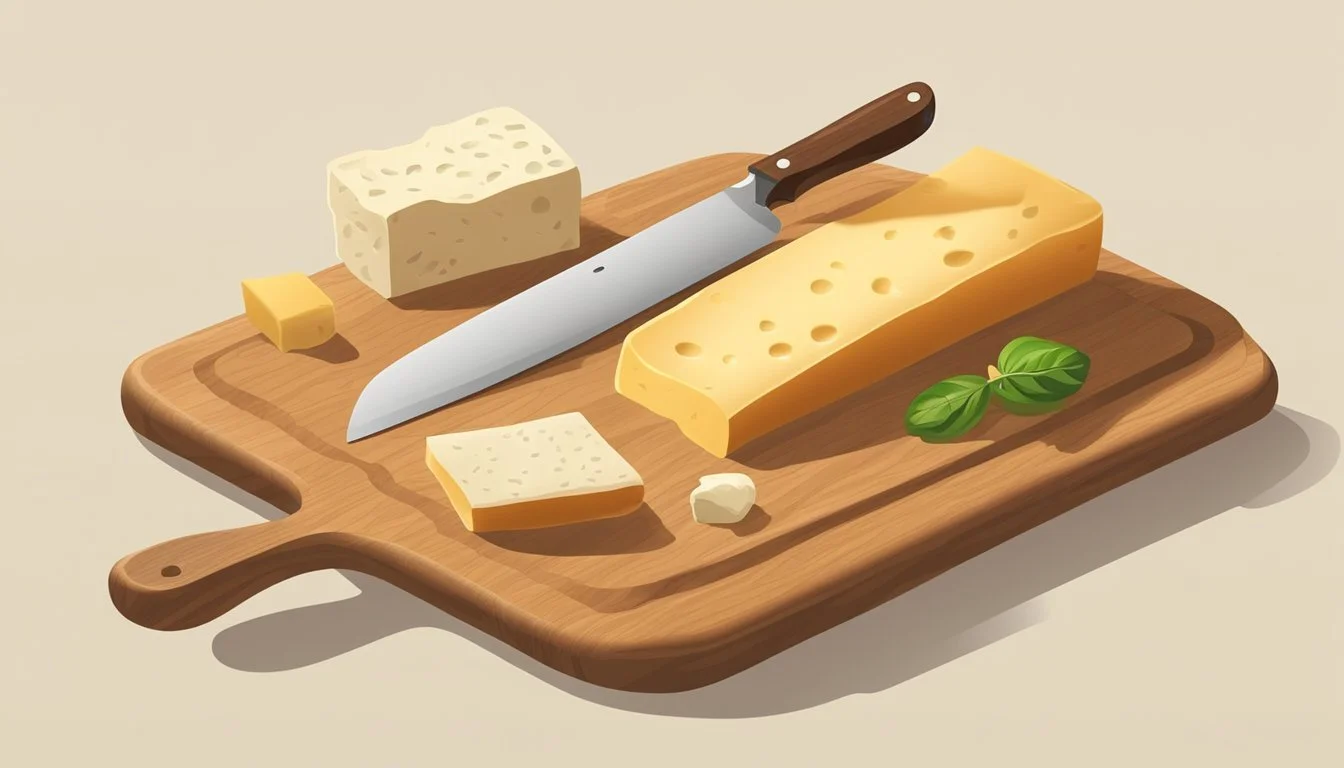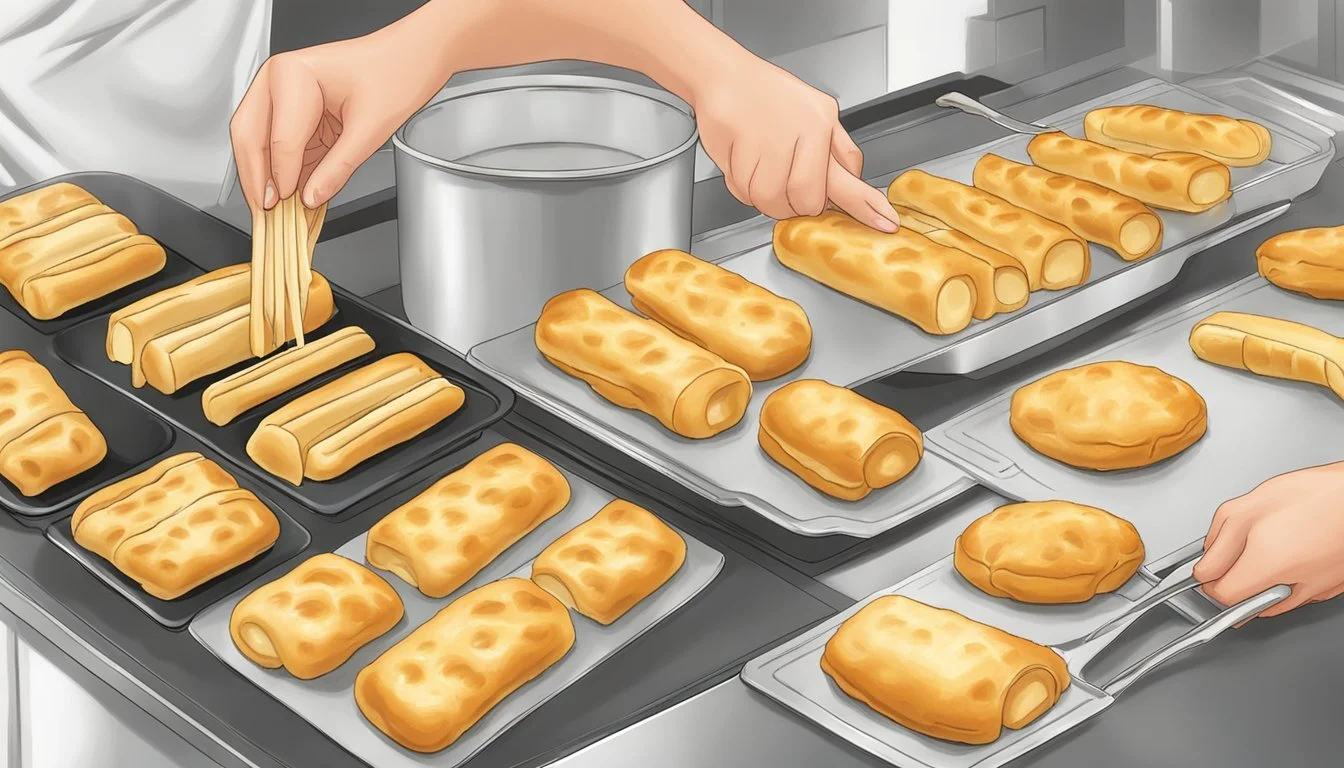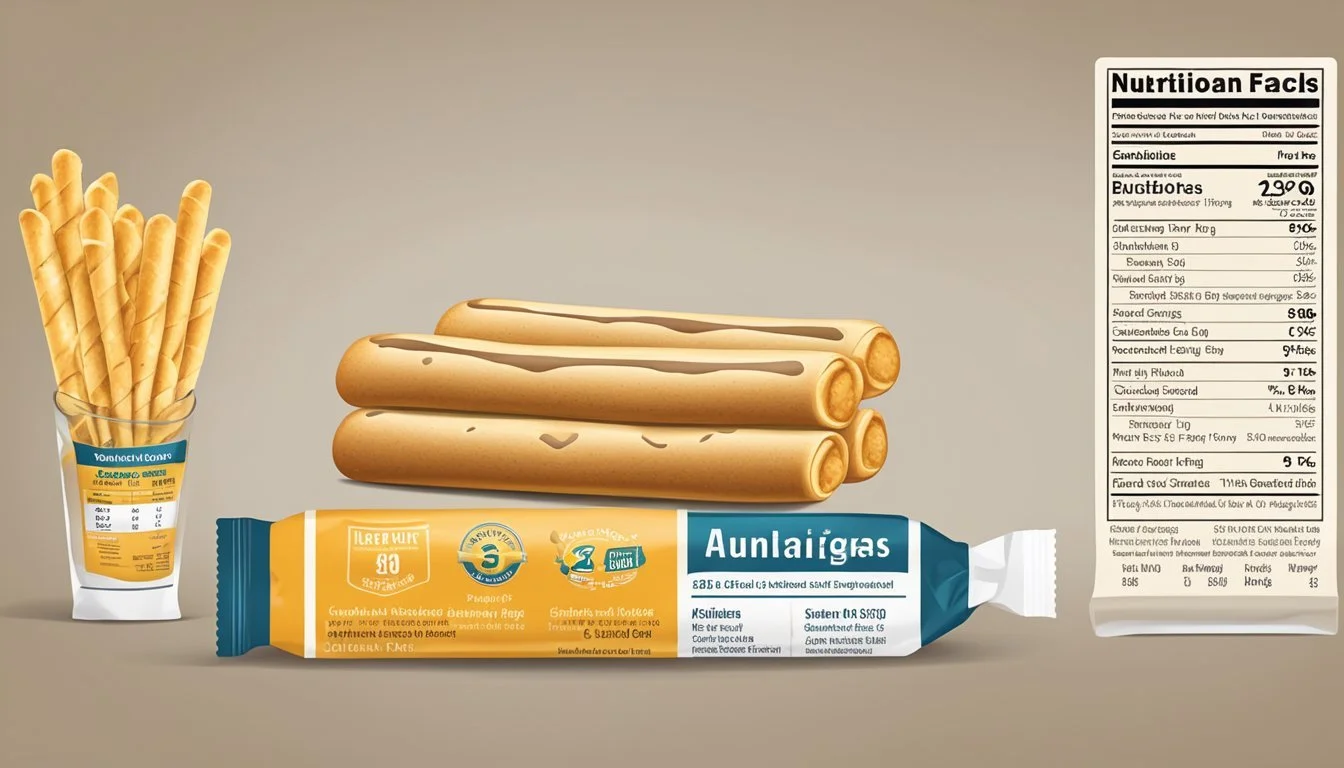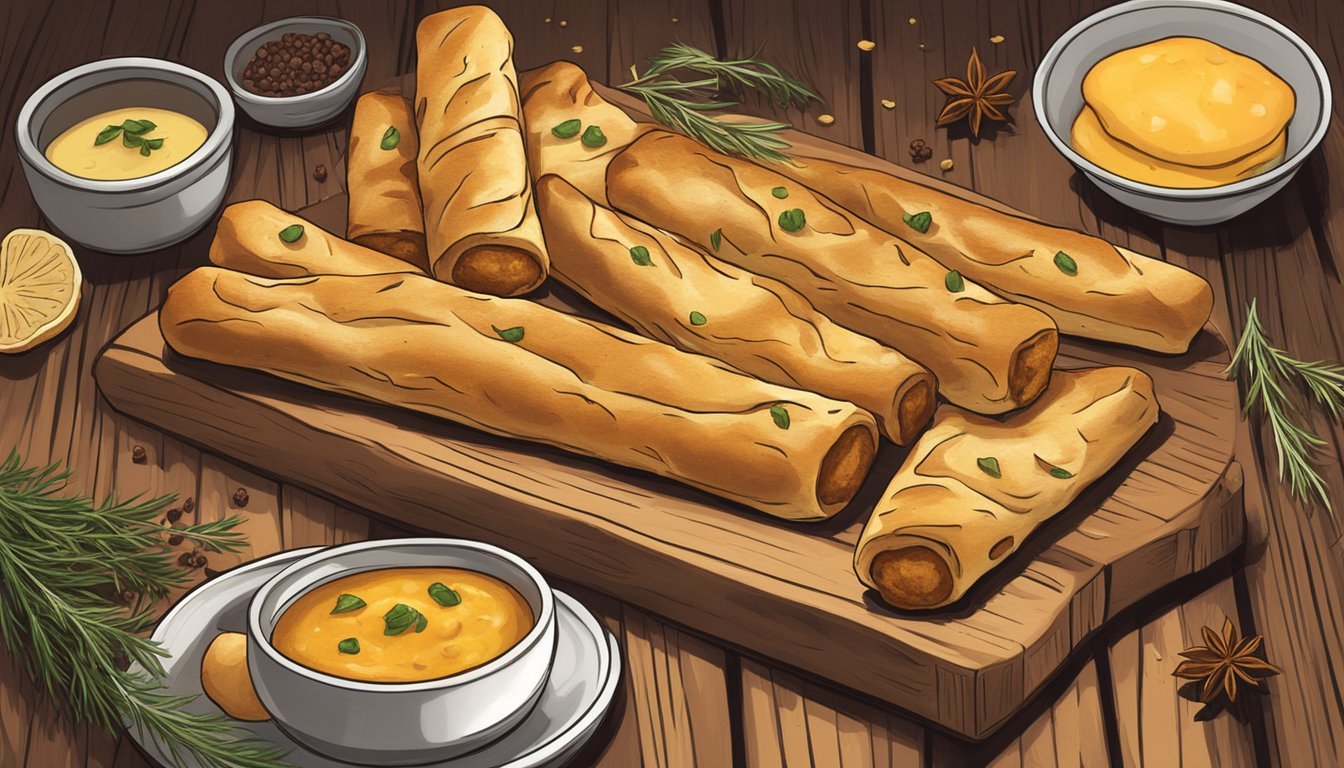How Long Do Beef and Cheese Stuffed Breadsticks Last?
Storage Tips
Storing and preserving the deliciousness of beef and cheese stuffed breadsticks can extend their enjoyment beyond the initial bake. For homemade varieties, these tasty treats can last up to five days when stored in an airtight container in the refrigerator. To maintain their freshness and flavor, it's crucial to keep them cool and dry. Unopened, store-bought beef and cheese stuffed breadsticks often have a shelf life of several weeks past their expiration date if kept in a cool, dry place.
When it comes to freezing, beef and cheese stuffed breadsticks can remain in good condition for up to three months. Wrapping them tightly in plastic wrap or aluminum foil before placing them in a freezer bag can help preserve their texture and taste. Reheating is simple—just pop them in the oven until they're warmed through and enjoy them as if freshly baked.
Knowing how long beef and cheese stuffed breadsticks last helps in planning meals and reducing food waste. By following proper storage techniques, one can relish these savory snacks over a longer period without compromising quality or flavor.
What Are Beef and Cheese Stuffed Breadsticks?
Beef and cheese stuffed breadsticks are a savory snack or appetizer combining tender ground beef and melted cheese, wrapped in a soft dough.
Ingredients typically include ground beef, mozzarella or parmesan cheese, and dough.
Families often enjoy these whether as a dinner side dish or a snack.
To prepare, the ground beef is cooked and seasoned, then placed into strips of dough alongside cheese.
Each breadstick is rolled and sealed to contain the filling.
Garlic powder or Italian seasoning can be brushed on top, adding layers of flavor.
Common cheeses used are mozzarella and parmesan, which melt beautifully inside the breadstick.
These breadsticks can be an enjoyable project for kids and are likely to be a hit at family gatherings.
Ingredients and Equipment Needed
Creating delicious beef and cheese stuffed breadsticks requires selecting the right ingredients and utilizing appropriate equipment to ensure the best results. This section focuses on the essential components and recommended tools for crafting these savory snacks.
Essential Ingredients
Pizza Dough: Use freshly prepared or store-bought pizza dough, divided into equal pieces. Each piece should be rolled out to about 4x3 inches.
Ground Beef: Cooked and seasoned ground beef adds a rich, savory flavor to the breadsticks.
Cheese: String cheese or mozzarella sticks work well, as they melt beautifully and provide a gooey center.
Melted Butter: Brushed over the breadsticks before baking for a golden, flavorful crust.
Garlic Powder and Salt: Added to melted butter for enhancing taste.
Flour: Needed for dusting the work surface to prevent dough from sticking.
Recommended Equipment
Rolling Pin: Essential for rolling out the pizza dough evenly to the desired size.
Pizza Cutter: Useful for cutting the dough into individual sections.
Baking Sheet: A large, nonstick baking sheet or one lined with parchment paper to bake the breadsticks evenly.
Parchment Paper: When lining the baking sheet, it ensures the breadsticks do not stick and allows for easy cleanup.
Nonstick Cooking Spray: Spraying the baking sheet prevents the breadsticks from sticking.
Small Mixing Bowl: For mixing melted butter with garlic powder and salt before brushing on the breadsticks.
Tongs: Handy for handling the hot breadsticks after baking.
These tools and ingredients are key to achieving perfectly baked beef and cheese stuffed breadsticks with minimal mess and maximum flavor.
Preparation and Cooking Instructions
Homemade cheese and beef stuffed breadsticks are both flavorful and easy to prepare. By following these steps, you can ensure they are stuffed correctly, baked to perfection, and ready to be enjoyed.
Dough Preparation
Start with preparing the dough, which acts as the foundation of the breadsticks. Use fresh, high-quality ingredients for the best results. Combine flour, yeast, salt, and water to form a smooth dough. Knead the dough thoroughly until it is elastic and smooth.
Allow the dough to rise in a warm place until it doubles in size. This process typically takes about 1-2 hours. Punch down the dough and roll it out on a floured surface into a large rectangle, about 1/4 inch thick. This ensures the dough is evenly distributed and ready for the filling.
Filling and Shaping
Begin by preparing the filling. Cook ground beef in a skillet until it is browned and fully cooked, then drain any excess fat. Season the beef with salt, pepper, and other preferred spices. Let it cool slightly before assembling the breadsticks.
Place cheese sticks onto the rolled-out dough, spacing them evenly. Spoon the cooked beef mixture next to the cheese sticks. Cut the dough into strips, each containing a cheese stick and beef. Carefully roll each strip, ensuring the cheese and beef are fully enclosed. Pinch the edges tightly to prevent the filling from leaking during baking.
Baking Process
Preheat your oven to 375°F (190°C). Arrange the stuffed breadsticks on a baking sheet lined with parchment paper, spacing them 2-3 inches apart. This prevents them from sticking together as they bake.
Melt some butter and mix it with garlic powder for added flavor. Brush the tops of the breadsticks with the garlic butter. Bake for 12-14 minutes or until the breadsticks are golden brown and the dough is cooked through.
Remove from the oven and let them cool slightly before serving. This allows the cheese to set and avoids burning your mouth.
By following these instructions, you can enjoy delicious, homemade cheese and beef stuffed breadsticks.
Proper Storage Techniques
Proper storage of beef and cheese stuffed breadsticks is essential to maintaining freshness and preventing spoilage. Storing breadsticks correctly involves refrigeration and sometimes freezing, depending on how long you wish to keep them.
Refrigerating Breadsticks
Beef and cheese stuffed breadsticks should be refrigerated within two hours of baking to ensure they stay fresh. Use an airtight container to prevent moisture loss and contamination. Breadsticks will stay fresh in the fridge for up to a week.
Before storing, let the breadsticks cool completely. Wrapping each breadstick individually in plastic wrap or aluminum foil can provide an additional layer of protection. It also helps if you plan to grab just one or two without exposing the others to air.
Properly refrigerated breadsticks can be reheated in the oven at 350°F for about 10 minutes, or until heated through. If reheating in a microwave, use a damp paper towel to cover the breadstick to retain moisture.
Freezing and Thawing
To extend the shelf life beyond refrigeration, freezing is an effective method. Once the breadsticks have cooled, place them in a single layer on a baking sheet and freeze until solid. This prevents them from sticking together. After freezing, transfer them to an airtight container or a freezer-safe bag.
Store-bought pizza dough or pre-made dough breadsticks stored in the freezer can last up to three months. Label each container with the date to keep track.
When ready to eat, thaw the breadsticks in the refrigerator overnight. For quicker results, thaw them at room temperature for a few hours. Reheat in the oven at 350°F until fully warmed. Avoid microwaving straight from the freezer, as it can make the breadsticks soggy.
Using marinara sauce for dipping can enhance the reheated breadsticks' flavor and texture.
Shelf Life and Food Safety
When storing beef and cheese stuffed breadsticks, paying attention to food safety is crucial. Refrigeration and proper handling can significantly extend their shelf life.
Refrigerated Shelf Life
Typically, beef and cheese stuffed breadsticks will last 3 to 4 days in the refrigerator when stored in an airtight container at or below 40°F (4°C). Refrigerating helps slow down bacterial growth, ensuring the breadsticks remain safe to eat.
Freezing Guidelines
To extend their shelf life, consider freezing. Properly sealed in airtight containers or heavy-duty aluminum foil, these breadsticks can last up to 2 months in the freezer. Freezing helps preserve both the fat content in the cheese and the quality of the beef.
Food Safety Tips
Always refrigerate leftovers within two hours of cooking.
Label containers with storage dates.
Reheat to an internal temperature of 165°F (74°C) before consuming to ensure safety.
Important Considerations
Avoid leaving stuffed breadsticks at room temperature for more than two hours. Shelf-stable components like hard cheese can last longer, but the combination with beef and the bread itself necessitates quicker consumption or proper refrigeration.
Overall, adhering to these guidelines helps maintain the quality and safety of your cheesy bread while preventing foodborne illnesses.
Heating and Serving Suggestions
Reheating beef and cheese stuffed breadsticks properly preserves their flavor and texture. Try serving them with various dipping sauces to enhance your appetizer or meal.
Reheating Options
Beef and cheese stuffed breadsticks can be reheated using different methods. Microwaving is quick and easy. Wrap the breadsticks in a damp paper towel and microwave on medium power (30-50%) for 45-60 seconds. This retains moisture and prevents them from becoming dry.
Oven reheating delivers a crispier result. Preheat the oven to 350°F (177°C), place the breadsticks on a baking sheet, and bake for 10-15 minutes. For extra flavor, brush with melted butter before baking. These steps ensure the breadsticks remain soft inside with a perfect outer crisp.
Serving Ideas
Serve beef and cheese stuffed breadsticks with a variety of dipping sauces to complement their savory flavors. Marinara sauce is a classic choice, adding a tangy contrast. Ranch dressing and honey mustard offer creamy and sweet options.
Pair the breadsticks with main dishes like spaghetti, lasagna, or a hearty soup. As an appetizer, they work well with salad or antipasto. Garlic Alfredo sauce provides a rich, indulgent option for dipping. These combinations make serving stuffed breadsticks both versatile and delightful.
Nutritional Information
Beef and cheese stuffed breadsticks are a delightful snack, but it's important to know their nutritional content for a balanced diet.
Here is a breakdown of the general nutritional values:
Nutrient Amount Per Serving Calories 220-250 Total Fat 10-13g Saturated Fat 5-7g Protein 8-10g Carbohydrates 24-28g Dietary Fiber 1-2g Sodium 400-600mg
Calories: Each serving typically contains between 220 to 250 calories, depending on the recipe and portion size.
Protein: These breadsticks are a good source of protein, providing around 8 to 10 grams per serving, largely due to the cheese and beef inside.
Carbohydrates: Serving sizes contain approximately 24 to 28 grams of carbohydrates, primarily from the dough.
Total Fat: Fat content ranges from 10 to 13 grams, with saturated fat making up a significant portion due to the cheese, about 5 to 7 grams.
Fiber: Dietary fiber content is modest, typically around 1 to 2 grams per serving.
Sodium: Sodium levels can be relatively high, often between 400 to 600 milligrams, due to added salt in the dough and fillings.
Monitoring these nutritional factors can help maintain a balanced diet while enjoying beef and cheese stuffed breadsticks.
Pairing with Meals
Beef and cheese stuffed breadsticks can be a delightful addition to a variety of meals. Consider pairing them with dishes and beverages that enhance their flavors and textures for a well-rounded dining experience.
Complementary Dishes
Pasta: A hearty pasta dish, like spaghetti or fettuccine Alfredo, pairs wonderfully with beef and cheese stuffed breadsticks. The creamy or tomato-based sauces complement the savory flavors of the breadsticks.
Salads: A crisp, refreshing salad can balance the richness of the breadsticks. A Caesar salad with its tangy dressing, or a Greek salad with tomatoes, cucumbers, and feta cheese, works particularly well.
Soup: Warm soups such as tomato basil, minestrone, or beef stew can be a cozy accompaniment. The breadsticks can be dipped into the soup, adding a flavorful and satisfying element to the meal.
Pizza: Pair the stuffed breadsticks with a simple margherita pizza or a more loaded pizza featuring meats and vegetables. The combination offers a diverse yet harmonious blend of flavors.
Cheese Breadsticks & Dipping Sauce: Serving cheese breadsticks alongside beef and cheese stuffed breadsticks with a variety of dipping sauces like marinara, garlic butter, or ranch can provide an array of textures and tastes.
Beverage Recommendations
Wine: Red wines like Merlot or Cabernet Sauvignon can complement the beef and cheese in the breadsticks. For those who prefer white wine, a crisp Pinot Grigio or Sauvignon Blanc can balance the meal.
Beer: A light beer, such as a Pilsner or Lager, can provide a refreshing contrast. For more intense flavors, try a Pale Ale or a Belgian Tripel to match the robustness of the beef.
Non-Alcoholic: For non-alcoholic options, consider serving iced tea or lemonade. The tartness of lemonade can cut through the richness, while iced tea offers a smooth beverage that pairs well without overwhelming any flavors.
Sparkling Water: If you prefer something lighter, a chilled sparkling water with a twist of lemon or lime can cleanse the palate between bites and help keep the meal refreshing and light.
Creative Variations and Homemade Recipes
Beef and cheese stuffed breadsticks offer a world of possibilities through various ingredients and homemade approaches. These options make it easy to customize the dish according to individual preferences.
Alternative Ingredients
Different types of cheese can be used to add unique flavors. Mozzarella, cheddar, and even sliced cheese sticks are great alternatives. For a tangy twist, consider incorporating blue cheese or feta.
To enhance the flavor, sprinkle in some Italian seasoning or dried basil. These herbs can elevate the taste without much effort.
Swapping out the beef for other proteins, such as Italian sausage or chicken, adds variety. For a vegetarian option, try stuffing them with a mix of spinach and ricotta cheese.
These alternative ingredients not only diversify the dish but also cater to different dietary preferences and taste profiles.
Homemade Alternatives
Using homemade pizza dough provides a fresher taste and better control over ingredients. It is a healthier option compared to store-bought dough.
Homemade pizza sauce also adds a personalized touch. Combining tomato puree, garlic, basil, and a touch of olive oil can create a rich, savory sauce.
For a fun and shareable dish, consider making monkey bread with beef and cheese stuffing. Cut the dough into pieces, stuff them, and arrange them in a baking dish for a pull-apart experience.
These homemade alternatives ensure that each bite is packed with flavor and made with love, perfect for family gatherings or casual dinners.
Frequently Asked Questions
How long do beef and cheese stuffed breadsticks last?
Beef and cheese stuffed breadsticks generally have a shelf life similar to other perishable food items.
How should they be stored?
Whether store-bought from the grocery store or homemade, it is crucial to store them properly. They should be placed in an airtight container and stored in the refrigerator.
Can they be frozen?
Yes, freezing is a good option to extend their shelf life. Wrap the breadsticks tightly in plastic wrap and place them in a freezer-safe bag.
How long do they last in the fridge?
When stored in the refrigerated section or your home refrigerator, beef and cheese stuffed breadsticks usually last for about 3 to 5 days.
How about freezing?
In the freezer, they can last for up to 2 months. Make sure they're properly wrapped to avoid freezer burn.
How can you reheat them?
Reheating can be done in an oven preheated to 350°F for about 10 minutes. For a quicker option, a microwave can be used for about 1-2 minutes, though the texture might not be as crispy.
Any tips for serving?
Serve these breadsticks with marinara sauce for dipping. This enhances the flavor and adds a delicious touch to the meal.
Are there any cooking tips?
If you're baking them at home, ensure the oven is preheated and do not overcrowd the baking sheet. Bake until golden brown.
How can you tell if they've gone bad?
Look for signs such as an off smell, mold, or a slimy texture. If any of these are present, it's best to discard them.








